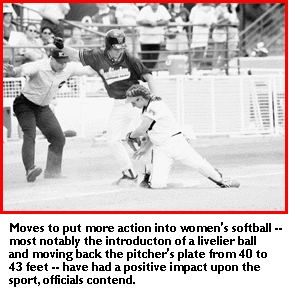
National Collegiate Athletic Association |
The NCAA News - News and FeaturesMarch 10, 1997 SPICIN' IT UP
Thanks to recent rules changes, softball succeeds at adding more offensive punch to its game
BY LAURIE BOLLIG Utah and Creighton played each other in the championship game of the Western Athletic Conference tournament in 1991.
Utah finally won, 4-3, to clinch a spot in the NCAA Division I Women's Softball Championship. The teams were on the field for 12 hours -- 6 p.m. May 11 through 6 a.m. May 12. Only eight runners crossed the plate -- not even an average of one runner an hour. Mary Higgins, Creighton's coach at the time, and former Utah coach Jo Evans can't even remember the scores of the games. "My parents," Evans joked, when asked if there were any fans left in the bleachers. Higgins said her son -- 6 years old at the time -- awoke to ask, "Hey, did we win the game?" A real snoozer. Dealing with perception Six years later, women's collegiate softball appears to be dealing with the perception that its game lacks offense and action. Last year's NCAA championship finals saw teams combine for 10 runs each in Divisions I and II and nine runs in Division III. Conversely, in 1982 -- the first year the NCAA sponsored softball championships -- the Divisions I and III final scores both were 2-0. The Division II champion won, 3-2. "I think the two moves that have changed the game were moving the mound back and the new ball," Arizona coach Mike Candrea said. "I personally think that it's helped us market our game because people are scoring runs. There's more action. It put the home run back in the game. I think those things have been great for the sport. "The extra-inning games you see are 4-4 instead of 1-0. These moves have put a premium on defense again. The more we've played with the ball, the more we've realized you have to have good pitching and good defense. Just about everyone can put the ball in play." Wildcat hitters certainly put the ball in play. Arizona players are ranked eight times among the top 10 Division I single-season run-scorers. Laura Espinoza specialized in putting the ball out of play. The Arizona letterwinner swatted a record 37 home runs in 1995. Just 10 years before, the single-season record was 18. More zip -- literally As Candrea said, a combination of rules changes over the last seven years has worked to put a little more zip in softball -- literally. In 1988 the pitcher's plate was moved to 43 feet -- back from the 40 feet mandated by Amateur Softball Association fastpitch softball rules. In the following years, the Divisions I, II and III Women's Softball Committees tinkered with fence distances, first recommending and then requiring 190-foot distances in left and right fields and 220 feet to center for regionals and championship finals. And in 1993, the softball committees voted to require use of an optic yellow ball with raised red seams for championship competition. Oh, and the ball is livelier, too. "The ball is extremely lively. If the goal was to make the game more exciting -- get more hits -- they definitely did that," Evans said. "Now the problem is the games are longer. Before, you could get through a game in one hour and 15 minutes. Now these games are going two hours. "So there are tradeoffs." Candrea adopted a "wait-and-see" attitude when the livelier ball was introduced in 1993. He's seen, and now he's a believer that the ball has spiced up the game, and in turn, brought fans to the ballpark. "Only the purist really loved the 0-0 game for 16 innings," Candrea said. "It's a really tough thing to market, television-wise. We're not where we need to be as far as the media are involved, but I think it's a great game right now." Effect on pitchers Pitchers bear the brunt of the rules changes. UCLA's Debbie Doom pitched 102 consecutive scoreless innings in 1984. In the last five years, the most consecutive scoreless innings pitched were by the Bruins' Lisa Fernandez and DeeDee Weiman, who both shut out opponents in 65 straight innings in 1992. "The dominant pitcher can still be dominant, but the term 'dominant' may have changed a little bit," Candrea said. "Instead of getting 12 strikeouts, they may get six, and their team will have to play defense." Candrea concedes that extra hitting and scoring lengthen what used to be a tidy 75-minute game. "That's maybe not the good part of it," he said. "But if you look, attendance around the country is up. I think it's because people come to see action. They don't want to see a 0-0 ballgame."
Site Content and Development copyright © 1997 National Collegiate Athletic Association
|
 Thirty-one innings, 220 at-bats and one run later, Creighton beat the Utes to force a second game -- which lasted 25 innings.
Thirty-one innings, 220 at-bats and one run later, Creighton beat the Utes to force a second game -- which lasted 25 innings.